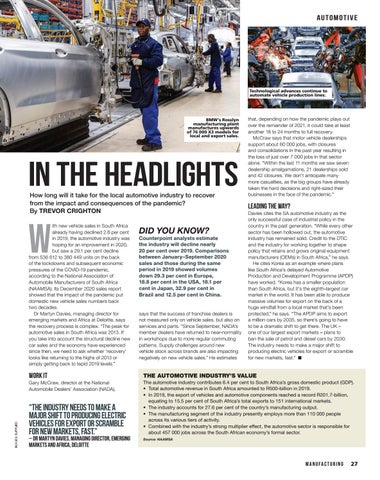AU T OMO T I V E
Technological advances continue to automate vehicle production lines.
BMW’s Rosslyn manufacturing plant manufactures upwards of 76 000 X3 models for local and export sales.
IN THE HEADLIGHTS How long will it take for the local automotive industry to recover from the impact and consequences of the pandemic? By TREVOR CRIGHTON
W
ith new vehicle sales in South Africa already having declined 2.8 per cent in 2019, the automotive industry was hoping for an improvement in 2020, but saw a 29.1 per cent decline from 536 612 to 380 449 units on the back of the lockdowns and subsequent economic pressures of the COVID-19 pandemic, according to the National Association of Automobile Manufacturers of South Africa (NAAMSA). Its December 2020 sales report showed that the impact of the pandemic put domestic new vehicle sales numbers back two decades. Dr Martyn Davies, managing director for emerging markets and Africa at Deloitte, says the recovery process is complex. “The peak for automotive sales in South Africa was 2013. If you take into account the structural decline new car sales and the economy have experienced since then, we need to ask whether ‘recovery’ looks like returning to the highs of 2013 or simply getting back to tepid 2019 levels.”
WORK IT
IMAGES: SUPPLIED
Gary McCraw, director at the National Automobile Dealers’ Association (NADA),
“THE INDUSTRY NEEDS TO MAKE A MAJOR SHIFT TO PRODUCING ELECTRIC VEHICLES FOR EXPORT OR SCRAMBLE FOR NEW MARKETS, FAST.”
– DR MARTYN DAVIES, MANAGING DIRECTOR, EMERGING MARKETS AND AFRICA, DELOITTE
DID YOU KNOW?
Counterpoint analysts estimate the industry will decline nearly 20 per cent over 2019. Comparisons between January–September 2020 sales and those during the same period in 2019 showed volumes down 29.3 per cent in Europe, 18.8 per cent in the USA, 18.1 per cent in Japan, 32.9 per cent in Brazil and 12.5 per cent in China.
says that the success of franchise dealers is not measured only on vehicle sales, but also on services and parts. “Since September, NADA’s member dealers have returned to near-normality in workshops due to more regular commuting patterns. Supply challenges around new vehicle stock across brands are also impacting negatively on new vehicle sales.” He estimates
that, depending on how the pandemic plays out over the remainder of 2021, it could take at least another 18 to 24 months to full recovery. McCraw says that motor vehicle dealerships support about 60 000 jobs, with closures and consolidations in the past year resulting in the loss of just over 7 000 jobs in that sector alone. “Within the last 11 months we saw seven dealership amalgamations, 21 dealerships sold and 42 closures. We don’t anticipate many more casualties, as the big groups have already taken the hard decisions and right-sized their businesses in the face of the pandemic.”
LEADING THE WAY? Davies cites the SA automotive industry as the only successful case of industrial policy in the country in the past generation. “While every other sector has been hollowed out, the automotive industry has remained solid. Credit to the DTIC and the industry for working together to shape policy that retains and grows original equipment manufacturers (OEMs) in South Africa,” he says. He cites Korea as an example where plans like South Africa’s delayed Automotive Production and Development Programme (APDP) have worked. “Korea has a smaller population than South Africa, but it’s the eighth-largest car market in the world. It has been able to produce massive volumes for export on the back of a huge windfall from a local market that’s been protected,” he says. “The APDP aims to export a million cars by 2035, so there’s going to have to be a dramatic shift to get there. The UK – one of our largest export markets – plans to ban the sale of petrol and diesel cars by 2030. The industry needs to make a major shift to producing electric vehicles for export or scramble for new markets, fast.”
THE AUTOMOTIVE INDUSTRY’S VALUE The automotive industry contributes 6.4 per cent to South Africa’s gross domestic product (GDP). • Total automotive revenue in South Africa amounted to R500-billion in 2019. • In 2019, the export of vehicles and automotive components reached a record R201.7-billion, equating to 15.5 per cent of South Africa’s total exports to 151 international markets. • The industry accounts for 27.6 per cent of the country’s manufacturing output. • The manufacturing segment of the industry presently employs more than 110 000 people across its various tiers of activity. • Combined with the industry’s strong multiplier effect, the automotive sector is responsible for about 457 000 jobs across the South African economy’s formal sector. Source: NAAMSA
MANUFAC TURING
27-33_automation .indd 27
27
2021/03/24 9:29 AM













